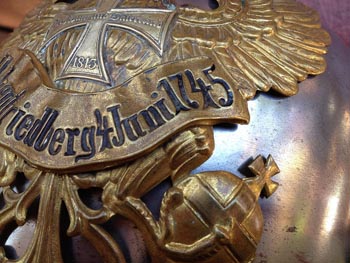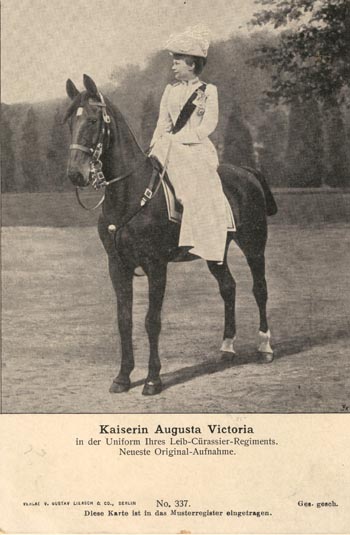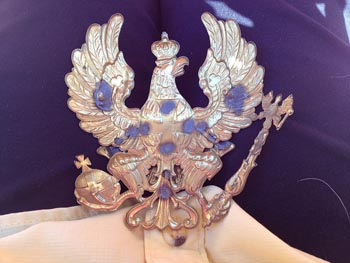Kürassier-Regiment Königin (Pommersches) Nr.2
Kürassier Regt Nr 2 Wappen
Joe Robinson
December, 2014.
| Our latest book is on the battle of Halen. In that engagement on 12 August 1914 four German cavalry regiments charged eight times into glory and disaster. It commonly became known as “The Battle of the Silver Helmets” because of a poem that was written after the battle. Of the four German cavalry regiments only one of them wore a silver helmet Kürassier Regt Nr 2 (KR2). This is a helmet from that regiment. It is an enlisted helmet with a Landwehr cross. While this is wonderful the absolutely original helmet and Wappen have a very unusual bandeau. | ||
| Kürassier-Regiment Königin (Pommersches) Nr.2 Pasewalk was the titular regiment for the Kaiser’s wife. With a regimental home in Pasewalk, there is still an exchange of visitors between this town and Halen.
ps1928 from Wiki Augusta was known as “Dona” within the family. She enjoyed a somewhat lukewarm relationship with her mother-in-law, Victoria, who had hoped that Dona would help to heal the rift between herself and Wilhelm; sadly, this was not to be the case. The Empress was also annoyed that the title of Head of the Red Cross went to Dona, who had no nursing or charity experience or inclination (though in her memoirs, Princess Viktoria Luise paints a different picture, stating that her mother loved charity work). |
|
|
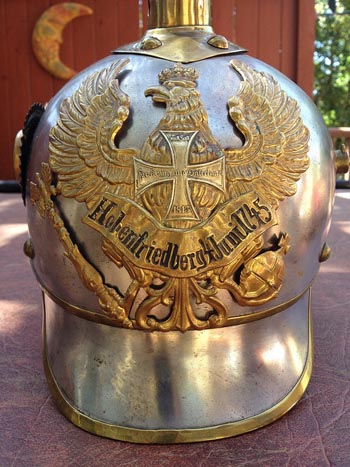 |
The helmet for this regiment carried a bandeau that commemorated the battle of Hohenfriedberg in 1745. This was a great victory for “Frederick the Great”. Later Prussian and German officers studied the charge of the Bayreuth Dragoons as a model for aggressiveness. Also, the encirclement and annihilation of the Austrian infantry and the quick and decisive manner in which this battle played out is also often likened to victory Schlieffen style. This battle showed that the Prussians could crush a numerically equal enemy during the last part of the War of the Austrian Succession.
As lineage and heritage would have it those dragoons eventually became Kürassier-Regiment Königin (Pommersches) Nr.2. They were authorized a bandeau on the eagle by AKO on February 7, 1861. The helmet style changed from a step visor to the rounded style in 1889. This appears to be a 1889 model helmet shell. |
|
| What is different about this and the purpose of the article is the bandeau shape. With the help of several people we seem to have uncovered a difference between active force Wappen and those Wappen that have a Landwehr cross. Specifically we’re looking at the end of the bandeau. The tail if you would. On the active forces you can see the tail going over the legs and extending down towards the feet of the Eagle. Looking at many pictures of active force bandeaus you could see this. For example this sample from the collection of Steve McFarland and compare it to the bandeau on this helme on the lower right. | 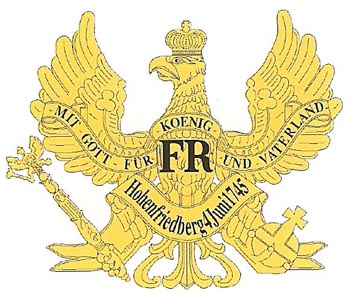 |
|
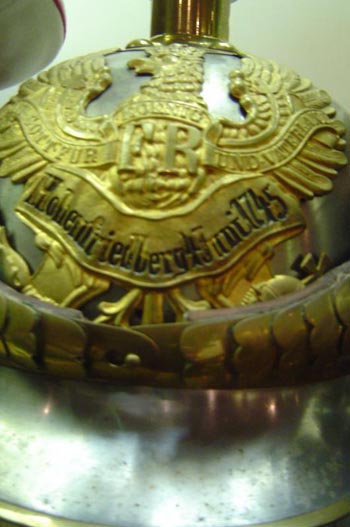 |
 |
|
|
|
Another clear difference between the active and reserve force Wappen is the lack of the motto. That is pretty standard as the motto was found on the Landwehr cross. You can compare that in the pictures above. There are a few other photographs that can deter any doubt. The back of the Wappen looks very good. You can see how the bandeau was put into place at the same time as the rest of the solder.
|
|
| This shows that bandeau was a separate piece. | 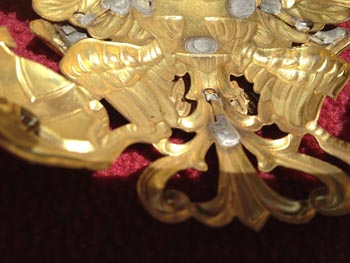 |
|
| This picture of the back of an active officer’s plate from the Schaeffer collection shows that the bandeau was integral to the plate and done in one piece. The reserve one was obviously done in two pieces. | ||
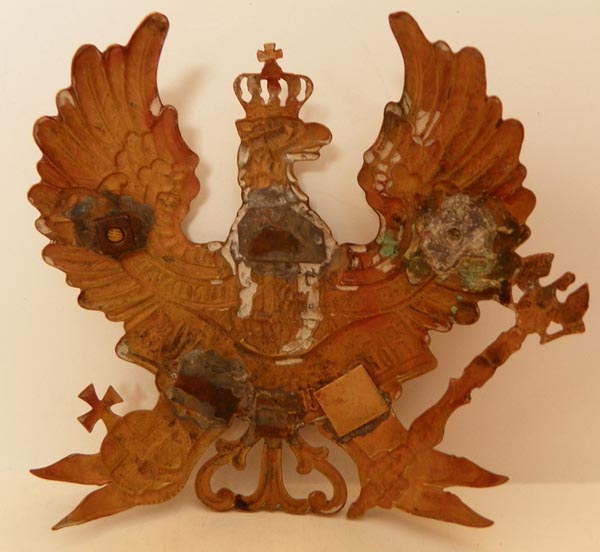 |
||
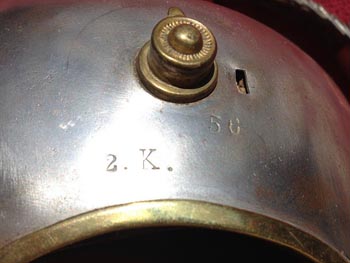 |
Marked to the Regiment underneath the left ear it also has the updated M91 post instead of the old threaded screw attachment as per the directive of 18 May 1894. | |
| But then we have this. What is up with all the holes? One easily gets the impression that this shell has been repurposed. Updated from an earlier model into the current 1889 configuration.
Now there are problems with that theory also. When the helmets changed from the 1867 model to the 1889 model the reinforcing ridge on the back was eliminated. This helmet did not have a ridge. So is the idea/impression wrong? Well here is another idea. The even older models going back to 1842 had a different kind of bandeau all together. The older version as seen from this picture from the Weitze website went around the base of the shell. Though you cannot see from those pictures the method of attachment is that what that hole in the bottom center of the shell is all about? There is no ridge on the back of an 1842 style helmet. Could this shell be from that long ago? |
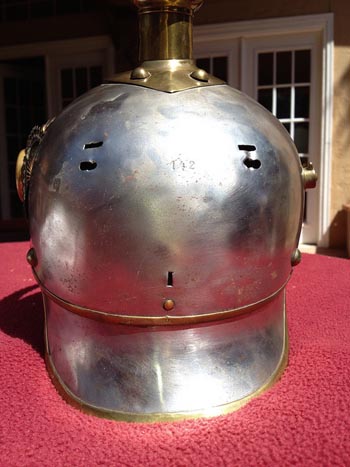 |
|
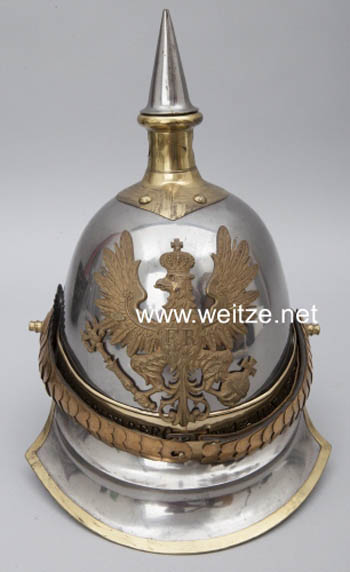 |
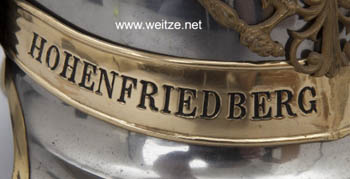 |
|
| Alas no it was a splendid but misguided thought. The flat holes are therefore split rivets to retain the liner band. One in the front and the other ones by the M91 posts. The horizontal slots indicate the use of loops on the back of one Wappen. I guess we will never know why there are two sets of holes for Wappen. A special thanks to R1 who nudged me consistently and kept my crazy ideas from running off the tracks. An interesting study! | ||
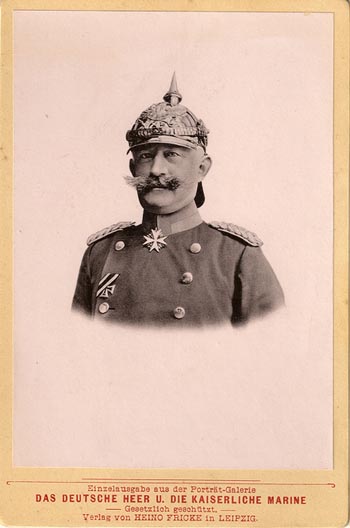 |
Oberst (17.2.03 A) Otto v. Schwerin, Regimental Commander of Kürassier-Regiment Königin (Pommersches) Nr. 2 from 15 December 1900 until assuming command of the 10. Kavallerie-Brigade on 22 April 1905. Oberst v. Schwerin commanded his brigade initially in the rank of a Colonel until his promotion to Generalmajor on 14 April 1907. He retired on 18 February 1908 and was recalled to service in WW1, serving as the commander of the 20. Infanterie-Brigade home command and simultaneously as a sector commander in Fortress Posen. On 8 June 1915 he became a sector commander in Gouvernement Libau and deputy Governor of Libau from 6 August 1915 until 30 November 1916. He received a brevet promotion to Generalleutnant on 27 January 1916. Born on 27 July 1851, he died on 13 October 1939. An absolutely wonderful portrait.
All of this from Glenn J. |
|
| And as a parting shot a picture from all our upcoming book “The Last Great Cavalry Charge.” – An officer from KR2. | 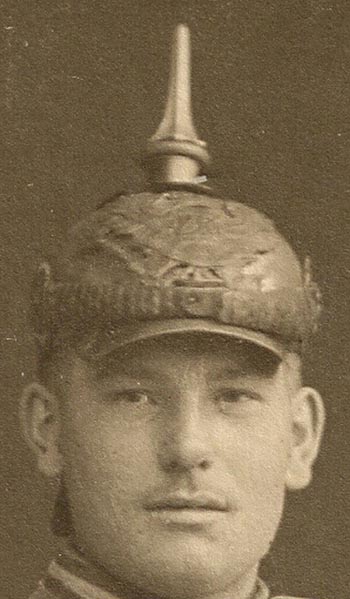 |
|
 |
The great learning experience from this has been about the Wappen. based on the keen observation of a collector from the West Coast of Canada it seemed as though helmets with a similar type of bandeau Might follow the same pattern – Active Wappen with “tails” and reserve wappen without. This is reinforced by several examples such as this one of Fusilier Regts. 33-34 in Johansson p. 41, Stubbs on pgs. 134-35. There were also some artillery battalions that employed this style of bandeau, but pics of reservist’s helmets are hard to find…
However, there is an example in Johansson on p40 of a Reserve GR9 officer helmet (Colberg 1807) with the tails.What this seems to indicate is that reserve plates with absent tails are merely a variation rather than an official mandate… This is validated by an absolutely wonderful example provided by Bruno Peault showing the exact opposite of the example on the left. The bottom line is that there are two variations on these bandeau and they do not seem to fit any kind of special pattern. I don’t think you’ll find this in any reference book. |
|
 |
||

